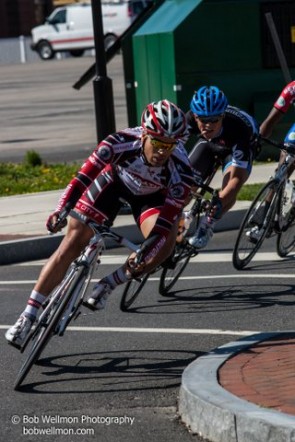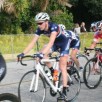Here we interview CRCA coach and Eumaeus/Fuoriclasse racer Ann Marie Miller along with some of CRCA's best male crit riders--Dan Chabanov and Alex Bremer of CRCA/Foundation and Colin Jaskiewicz of Champion System p/b Stan's NoTubes--for their tips on preparing for and racing criteriums. What suggestions do you have for training for crits?
Ann Marie Miller--Criterium racing consists of multiple loops of a
course that is generally between 1km and 1.5 miles long, so you need to be prepared for repeated short, explosive efforts as the field accelerates out of corners, as well as for primes, attacks and of course the final sprint.
In an athlete’s training program, a good time to include race-specific drills is the Specialization (pre-competition) training period. To improve repeatability for short, explosive efforts, I like starting with sets of 4 – 6 short VO2 max (high-intensity) efforts of 1-3 minutes in duration with equal recovery, or for newer riders, work/recovery of up to 1:3. Depending on your fitness level and experience, start with shorter high intensity intervals and longer recovery periods, and as you gain fitness (or if you are a more advanced athlete), go for a longer work effort, and shorter recovery, though not less than work/recovery of 1:1. Keep the cadence relatively high, 95-110rpm’s, and build up to the desired intensity within the first minute, then hold that intensity for the length of the interval. Recover with easy spinning in a light gear. For maximal power and best results, work efforts should not exceed 3 minutes duration.
Alex Bremer -- To be good at crits you can get away with less volume of training
than for a long road race or stage race, so in that sense its "easier" to train for crits, especially as a 9-5'er. Some specific workouts I like include:
Long tempo efforts with sprints every 2-3 minute 2-3x15-20 minutes threshold 4-6x5 minute sustained max power with full recovery 5-10x1 minute efforts with full recovery, basically starting at max and riding yourself to pieces in the minute Any form of tataba (30/30's, 15/15's, 12/18's all are max/rest), usually 3-5 sets of 3-5 minutes
What recommendations to you have for warm-up before the crit?
Dan Chabanov - What I do generally depends on where the race is and what's available to us. I'll try to spin for half an hour or forty-five minutes with a few quick jumps thrown in for good measure.
Colin Jaskiewicz-- We generally start off with an easy hour ride in the morning to get the legs moving so that it only takes 20-30 minutes of rolling around before the race to feel ready.
Ann Marie Miller -- Do 30-45 minutes on the trainer, including a gradual aerobic warm-up (10-15 min), 5 min. of Fast Cadence Intervals, then back to an Endurance Pace for 3-5 min. Include 2 – 3 short, high intensity intervals of 2 minutes each, with 2 minutes Recovery between efforts. Finish your trainer session with 2-3 minutes easy spinning. Then head to the road & for another 5-10 minutes including 2-3 sprints (15 seconds each). Recover with an easy spin & go directly to the start.
Do you have some tips for the start?
Alex Bremer -- The race starts before the race. Find a spot to enter the course as close to the finish line as possible, preferably behind it. Be there 15 minutes before the start, and hop into position as soon as the last rider finishes the race before yours. If you haven't seen the course, it's probably worth taking a lap, but it's better to get the recon laps done early and take the best position you can when riders hustle to line up.
Dan Chabanov -- If you have a call up for your start, congratulations! The rest of us generally have to fight in the cattle call to the line for a decent spot. . . Starting in the back? Get ready to waste some energy. It's better to waste your energy moving up right away then wasting it braking in too every corner at the back of the field. If you're at the back you have a great view of the race but you're not actually in it. So move up.
Ann Marie Miller -- Practice clipping in and accelerating quickly; usually crits are fast right from the gun – be ready!!!
What suggestions do you have for overall race strategy?
Colin Jaskiewicz-- The key to a successful crit is dependent
on your strengths as a rider and the race. First, look at the race, some are almost always field sprints, and others breaks. Take Somerville and Basking Ridge as an example; one is a fast, flat, and wide course, the other has twice as many turns, is one lane wide with a hill in half the distance per lap. Knowing the race allows you to come up with a strategy.
At a race like Somerville, I know that 90% of the time it will be a field sprint. So I spend the entire race trying to pedal as little as possible by sitting on the back and taking them as fast as possible so that I don't need to sprint back up to speed. In the closing laps you'll have a bit more left when you need to move up that spot or two in the wind to keep position for the sprint.
On the other end of the spectrum, a race like Basking Ridge is race where the field shatters from the gun. Making acceleration after acceleration, takes its toll quickly, and if you're not top 40 it is close to impossible to have any chance of seeing the front. A race like this is one where being attentive and staying as close to the front as possible will pay off in the end.
Once you know the (likely) outcome of a race you can come up with a game plan based on your strengths.
Ann Marie Miller--Know your strengths & have a plan that utilizes your strengths. If you are not good at long, sustained efforts, trying a solo break probably won’t work. If you are not a strong sprinter, try to get in a break. If you have little sustainable power, try to stay on wheels & perfect your timing in a sprint.
So you have a plan for the race as a whole, what suggestions do you have for riding in the pack in a crit?
Ann Marie Miller-- Stay ”in the moment.” Even if you have a plan, things may not go as you expect, so you have to be resilient and respond decisively to the situation at hand.
Dan Chabanov -- Crits are fast and dynamic races. A lot
can happen in the span of 45 or 90 minutes. The important thing is to be close enough to the pointy end of the race to actually be in it. The sweet spot is generally far enough back that you have some shelter but close enough to the front that you don't need to hit the brakes through the turns. Get it right and you will be amazed at how effortlessly you will be sucked along the course. Get it wrong and suddenly your working twice as hard. The challenge is that everyone wants to be in that sweet spot and with constant surges, attacks, and counter attacks the best thing you can do to find a good result in the crit is constantly have your head in the game. Relaxing is a great way to suddenly find your self at the back. Crits are all about holding position in the field. Being in the right place at the right time to go with a promising move or to counter attack something that just came back. If you're riding for the sprint its the same thing. Riding in the right position saves you energy. You can have the best sprint in your field but if you try to use it from 15 wheels back (after you just wasted a ton of matches trying to get to the front of the race) you'll be lucky to get anywhere near a result.
Alex Bremer -- Always try to leave yourself some lines to move up, so that as the field folds over itself with riders surging/attacking up the sides you can move up with them...The goal being never to fall further than about 20 wheels back, to keep speed through the turns and keep off the brakes.
Keeping off the brakes in general is hugely important. That means letting yourself drift forwards between the wheels of riders in front of you instead of braking and staying in line, and it means staying calm in traffic and not grabbing for your brakes all the time...One idea might be to leave the brakes a little looser to condition yourself to use them less, because most of the braking isn't actually necessary.
Are there particular things to think about in trying to do a break in a crit?
Ann Marie Miller-- Watch for lulls in the action in the field & seize the opportunity to attack; you may draw out a few breakaway companions to share the load of staying away from the field. Your chances are always better in a break.
Alex Bremer--Tactically, crits favor small groups of riders more than a straight road, since they can find smooth, fast lines without fighting for space, meaning less braking and more pedaling. This could be a reason to be more aggressive in crits, as well as their short duration. A great place to attack if you're comfortable on the course is in the last 50 meters before a corner, since the group would only be able to send 5-10 riders full speed through the corner behind you, meaning less eager chasers.
What about the finish?
Alex Bremer--For the finish, the technical aspect of crits also means a 5 second gap can be hard to close, so a big move at one to three laps to go can work if you have the legs and the timing. Otherwise, think of preparing for a sprint by being within 5-10 places of where you hope to finish with 5 laps to go, and with 1 lap to go aim to be in the top 10. Usually, you want to be in the top 3-5 places in the last corner, depending on how long the sprint is. When in doubt, start the sprint further forward. And within the last 3-5 laps, work to eliminate as much mental doubt and extra thought as possible. The race only has 5-8 minutes left, so go hard, and let primal survival instincts take over.







